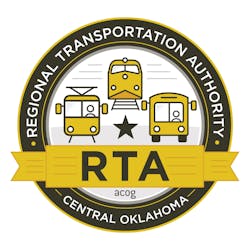Signing ceremony held to form RTA of Central Oklahoma
“Transportation is fundamental to economic development,” Mark W. Sweeney, AICP, executive director, Association of Central Oklahoma Governments (ACOG), said. “The RTA will help make our region more competitive, and our communities more vibrant.”
The RTA of Central Oklahoma will be governed by a seven-person board of directors. Each city will have one representative except Oklahoma City, which will have two based on its population and sales tax revenue.
“As the region’s metropolitan planning organization, this has truly been a regional effort and we are excited to have been such a significant part of it,” Sweeney said. “I’ve seen what is possible when a region has a shared vision. Together, we can implement transformational projects that will catapult Central Oklahoma into a brighter transportation future.”
AOCG, which has served as the coordinator of regional transportation efforts, will continue to provide critical administrative, legal and technical support during the RTA of Central Oklahoma’s inception and development. The support is open ended with Sweeney saying it could last up to five years, but longer if needed.
Sweeney says Central Oklahoma's population is expected to see an increase of half a million people by 2030 and the RTA of Central Oklahoma's formation will develop transportation options, mitigate traffic congestion and spur economic development.
“It will also improve air quality, and perhaps best of all, it will support neighborhoods and enhance quality of life. Knowing this, we look forward to our work over the next several years in guiding the RTA toward total independence,” said Sweeney.
About the Author

Mischa Wanek-Libman
Group Editorial Director
Mischa Wanek-Libman is director of communications with Transdev North America. She has more than 20 years of experience working in the transportation industry covering construction projects, engineering challenges, transit and rail operations and best practices.
Wanek-Libman has held top editorial positions at freight rail and public transportation business-to-business publications including as editor-in-chief and editorial director of Mass Transit from 2018-2024. She has been recognized for editorial excellence through her individual work, as well as for collaborative content.
She is an active member of the American Public Transportation Association's Marketing and Communications Committee and served 14 years as a Board Observer on the National Railroad Construction and Maintenance Association (NRC) Board of Directors.
She is a graduate of Drake University in Des Moines, Iowa, where she earned a Bachelor of Arts degree in Journalism and Mass Communication.
